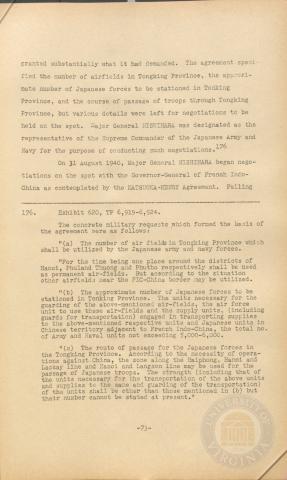
Page 73
| Parent | Japanese - German - Italian Collaboration |
|---|---|
| Date | |
| Language | English |
| Collection | Tavenner Papers & IMTFE Official Records |
| Box | Box 14 |
| Folder | Japan, Germany, Italy Collaboration and Introduction |
| Repository | University of Virginia Law Library |
granted substantially what it had demanded. The agreement speci¬fied the number of airfields in Tongking Province, the approxi¬mate number of Japanese forces to be stationed in Tonking Province, and the course of passage of troops through Tongking Province, but various details were left for negotiations to be held on the spot, ^ajor General NISKIHARA was designated as the
representative of the Supreme Commander of the Japanese Army and Navy for the purpose of conducting such negotiations. 176
On 31 August 1940, Major General NISHIHARA began nego¬tiations on the spot with the Governor-General of French Indo- China as contemplated by the MATSUOKA-HENRY Agreement. Failing
176Exhibit 620, TP 6,919-6,924.
The concrete military requests which formed the basis of the agreement were as follows:
"(a) The number of air fields in Tongking Province which shall be utilized by the Japanese army and navy forces.
"For the time being one place around the districts of Hanoi, Phuland Thuong and Phutho respectively shall be used as permanent air-fields. But according to the situation other airfields near the FIC-China border may be utilized.
"(b) The approximate number of Japanese forces to be stationed in Tonking Province. The units necessary for the guarding of the above-mentioned air-fields, the air force unit to use these air-fields and the supply units, (including guards for transportation) engaged in transporting supplies to the above-mentioned respective units and Japanese units in Chinese territory adjacent to French Indo-China, the total no. of Army and Naval units not exceeding 5,000-6,000.
"(c) The route of passage for the Japanese forces in the Tongking Province. According to the necessity of opera¬tions against^China, the zone along the Haiphong, Hanoi and Lackay line and Hanoi and Langson line may be used for the passage of Japanese troops. The strength (including that of the units necessary for the transportation of the above units and supplies to the same and guarding of the transportation) of the units shall be other than those mentioned in (b) but their number cannot be stated at present."
